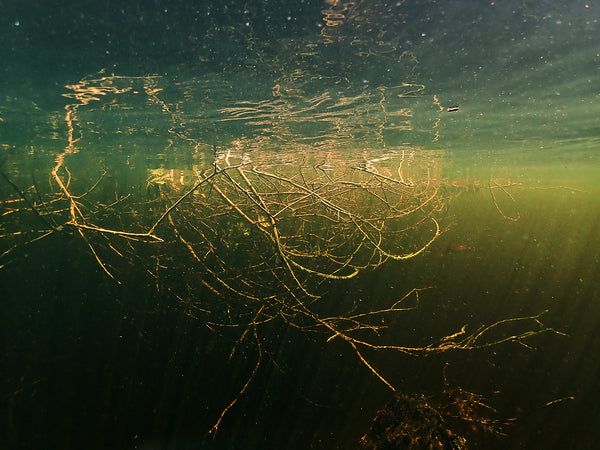- Continue Shopping
- Your Cart is Empty
A deeper dive into the roots...
The materials that we work with are our literal "palette", and they are more than just “set pieces” in our aquariums. They're also important for the function that they bring. The irony, as I see it, is that the greater aquascaping world more often than not simply fails to demonstrate, or even acknowledge in their work, the relationship between land and water, when the bulk of the materials used in aquascapes are of terrestrial origin.

What a strange disconnect!
And NO, being "inspired by" a mountain, or doing a "diorama-style" 'scape replicating a "cloud forest" using aquatic moss on glued-together Spiderwood pieces is NOT highlighting this relationship! 😆

The real land/water relationship is far different. It's more about soils, fallen trees, leaves, and root tangles. and further still, it's about epiphytic growth, and the foraging opportunities that they bring to our fishes.

We talk a lot about "microhabitats" in Nature; little areas of tropical habitats where unique physical, environmental and biological characteristics converge based on a set of factors found in the locale. Factors which determine not only how they look, but how they function, as well.

And we can replicate many of them with unique natural materials.
Now, small root bundles and twigs are not traditionally items you can find at the local fish store or online. I mean, you can, but there hasn't been a huge amount of demand for them in the greater aquascaping world lately...although my 'scape scene contacts tell me that twigs are becoming more and more popular with serious aquascapers for "detailed work"...so this bodes well for those of us with less artistic, more functional intentions! Apparently, if the more superficial sectors of the hobby create demand, the supply seems to follow..😆
Of course, we've been playing with these materials for years, for completely different reasons, because we are always approaching this stuff from a different angle.

And that "angle" is function. And the "muse" is Nature.
In flooded forests, roots are generally found in the very top layers of the soil, where the most minerals are. In fact, in some areas, studies indicated that as much as 99% of the root mass in these habitats was in the top 20cm of substrate! Low nutrient availability in the Amazonian forests is partially the reason for this. And since much of that root mass becomes submerged during seasonal inundation, it becomes obvious that this is a unique habitat.

So, ecological reasons aside, what are some things we as hobbyists can take away from this?
We can embrace the fact that most of these finer materials will function in our aquairums as they do in Nature, sequestering sediments, retaining substrate, and recruiting epiphytic materials which fishes will forage, hide, and spawn among.
You can use a lot of materials to create a very dense look of tangled root structures extending into the water. For example, Melastoma roots have a perfect, delicate structure, and when combined with other, smaller wood pieces of materials create a very unique, realistic look.

The nice thing about a tangled mix of roots is that it not only creates a unique aesthetic- it instantly creates a fascinating replication of a unique natural habitat for fishes. And of course, we botanical-style aquarists are in a unique position to experiment with- and reap the befits of- these amazing natural materials.

In an aquarium set up to take advantage of these materials and their function, as the roots begin to soften and ultimately break down, they will foster microbial growth, biofilms, and fungal growths- all of which will provide supplemental foods for the resident fishes...just like what happens in Nature.

Fungal growth, biofilms, and small crustaceans/microorganisms will live in the tangled matrix of small roots with enormous surface area. This has the dual advantage of functioning not only as a producer of supplemental food sources, but as a natural nutrient processing "facility" in the aquarium. This is a huge and important benefit provided by this type of assemblage.
Roots find their way into aquatic systems because..well- the aquatic system usually finds THEM! Areas of grasslands or varzea/igapo forest become flooded during seasonal inundations, and suddenly, the terrestrial habitat is transformed into a rich, productive- and unique-looking aquatic habitat, brimming with life.

Another absolutely perfect example of the intricate relationship between land and water that you simply won't get to truly appreciate if you don't allow those areas of biocover to accumulate.
So, yeah, we can deliberately and easily create what, in Nature occurs by happenstance.

Big takeaway here: The thing that is fascinating about roots is that they function in our aquariums just like they do in Nature. Utilizing these materials in our aquariums is an easy, interesting way that we can replicate and study this unique microhabitat.
You'll get to take a good, serious look at the elegance and function of these amazing natural ecological niches, which often go unnoticed by all but the most astute observers in the wild...right from the dry comfort of you own home.

Even in a more "aesthetic focused" display, roots can be allowed to accumulate the aforementioned epiphytic materials and to sequester sediments, to the advantage of our fishes, and to the delight of our senses!

I hope today's deeper dive into the roots gives you a bit more incentive, inspiration, and motivation to use readily-available materials to create unique and compelling aquatic habitats in your own home.
Say inspired. Stay fascinated. Stay engaged. Stay creative...
And Stay Wet.
Scott Fellman
Tannin Aquatics






Scott Fellman
Author